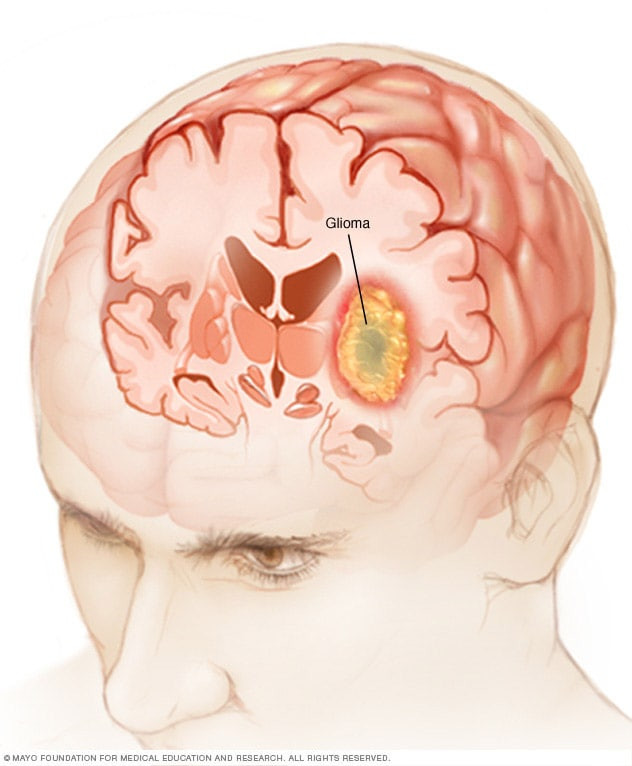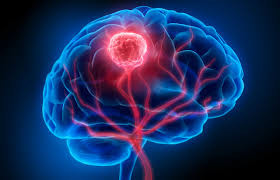Definisi
Glioma adalah suatu jenis tumor yang timbul pada otak dan saraf tulang belakang. Glioma timbul pada sel glia yang mengelilingi sel saraf dan membantu fungsi sel. Glioma adalah salah satu tipe tumor otak primer yang paling banyak ditemukan. Terdapat tiga jenis sel glia yang dapat memproduksi tumor. Glioma diklasifikasikan berdasarkan jenis sel glia yang terlibat dalam tumor serta ciri genetik dari tumor tersebut.
Tipe glioma meliputi:
- Astrositoma
- Ependymoma
- Oligodendroglioma
Mengetahui tipe glioma akan membantu memprediksi perkembangan tumor dari waktu ke waktu, pilihan terapi yang tepat, serta harapan untuk kesembuhan.
Penyebab
Seperti kebanyakan tumor primer otak, penyebab pasti glioma tidak diketahui. Namun, penelitian mengatakan bahwa adanya perubahan DNA mungkin menyebabkan timbulnya tumor otak dan tumor saraf tulang belakang seperti glioma.
Gen mengandung DNA yang memberi instruksi sel untuk bertumbuh dan membelah. Adanya mutasi atau perubahan pada DNA pada gen dapat menyebabkan sel membelah tidak terkontrol.
Faktor Risiko
Terdapat beberapa faktor yang dapat meningkatkan risiko tumor otak. Faktor risiko tersebut meliputi:
- Usia. Risiko terkena tumor otak meningkat seiring pertambahan usia. Glioma paling sering ditemukan pada orang dewasa berusia 45 sampai 65 tahun. Namun, tumor otak tetap dapat terjadi pada usia berapapun. Beberapa tipe glioma tertentu, seperti ependymoma dan astrositoma pilositik, lebih sering ditemukan pada anak-anak dan dewasa muda
- Paparan radiasi. Orang yang terpapar suatu jenis radiasi yang disebut dengan radiasi pengionisasi memiliki peningkatan risiko untuk tumor otak. contoh dari radiasi ionisasi adalah terapi radiasi yang digunakan untuk terapi kanker dan paparan radiasi yang disebabkan oleh bom atom. Bentuk radiasi yang lebih sering ditemui sehari-hari seperti radiasi elektromagnetik dari sumber listrik dan radiasi radiofrekuensi dari microwave oven tidak meningkatkan risiko glioma. Masih belum jelas apakah penggunaan ponsel meningkatkan risiko kanker otak. beberapa penelitian menemukan adanya kemungkinan kaitan antara penggunaan ponsel dan satu jenis kanker otak yang disebut neuroma akustik. Namun, banyak studi lain yang mengatakan sebaliknya. Hal ini masih memerlukan penelitian lebih lanjut. Saat ini, jika Anda khawatir mengenai kemungkinan adanya kaitan antara ponsel dan kanker, para ahli merekomendasikan untuk membatasi paparan dengan ponsel dengan menggunakan pembesar suara atau hands-free device, yang memungkinkan ponsel untuk berada lebih jauh dari kepala Anda
- Riwayat keluarga dengan glioma. Glioma jarang untuk diturunkan di keluarga. Namun, adanya riwayat keluarga dengan glioma dapat meningkatkan risiko Anda untuk terkena glioma sebanyak dua kali lipat. Beberapa gen dikaitkan dengan glioma, namun masih diperlukan studi lebih lanjut untuk mengkonfirmasi adanya kaitan antara variasi gen ini dan tumor otak
Gejala
Gejala glioma dapat bervariasi bergantung jenis, ukuran, lokasi, dan kecepatan pertumbuhan tumor. Gejala yang umum terjadi pada glioma meliputi:
- Nyeri kepala
- Mual atau muntah
- Bingung atau penurunan fungsi otak
- Gangguan memori
- Perubahan kepribadian
- Gelisah atau mudah tersinggung
- Gangguan keseimbangan
- Gangguan berkemih (tidak mampu menahan kemih, berkemih secara tidak sadar)
- Gangguan penglihatan seperti pandangan buram, pandangan ganda, atau kehilangan lapang pandang tepi
- Gangguan bicara
- Kejang, terutama jika seseorang sudah memiliki riwayat kejang sebelumnya
Diagnosis
Jika dokter mencurigai Anda mengalami tumor otak, maka Anda akan dirujuk ke dokter spesialis yang ahli dalam menangani penyakit otak dan system saraf (dokter saraf). Dokter juag akan merekomendasikan beberapa pemeriksaan dan prosedur seperti:
- Pemeriksaan saraf. Saat pemeriksaan saraf, dokter akan memeriksa penglihatan, pendengaran, keseimbangan, koordinasi, kekuatan, dan refleks. Adanya gangguan pada salah satu area tersebut dapat memberikan tanda mengenai bagian otak yang mungkin terkena tumor otak.
- Pemeriksaan radiologi. MRI sering digunakan untuk membantu diagnosa tumor otak. pada beberapaa kasus, zat warna (zat kontras) dapat disuntikan ke dalam vena lengan saat MRI untuk membantu menunjukan adanya perubahan pada jaringan otak. pemeriksaan lain yang dapat dilakukan adalah CT scan dan PET scan
- Pemeriksaan untuk menemukan kanker di bagian tubuh lain. Untuk menyingkirkan kemungkinan tumor di otak adalah penyebaran dari tumor di bagian tubuh lain, dokter mungkin akan merekomendasikan pemeriksaan dan prosedur untuk menentukan asal kanker. Glioma berasal dari dalam otak dan bukan merupakan hasil dari penyebaran kanker dari bagian tubuh lainnya
- Biopsi (pengambilan dan pemeriksaan jaringan yang abnormal). Bergantung pada lokasi glioma, biopsy dapat dilakukan dengan jarum sebelum terapi atau sebagai bagian dari operasi untuk mengangkat tumor otak. Biopsi jarum sterotaktik dapat digunakan untuk glioma pada area otak yang sulit terjangkau atau yang sangat sensitif yang dapat mengalami kerusakan jika dilakukan operasi yang lebih kompleks. Selama prosedur ini, dokter bedah saraf akan membuat lubang kecil pada kepala. Setelah itu, jarum kecil akan dimasukan melalui lubang tersebut. Jaringan akan dikeluarkan melalui jarum, yang biasanya dipandu dengan CT scan atau MRI. Sampel biopsy kemudian akan dianalisa di bawah mikroskop untuk menentukan tumor jinak atau ganas. Biopsi adalah satu-satunya cara untuk mendiagnosa tumor otak secara pasti. Berdasarkan informasi ini, dokter juga dapat menentukan stadium tumor otak. dokter juga akan memeriksa penampakan dan kecepatan pertumbuhan dari sampel biopsi yang akan membantu menentukan rencana terapi
Tata Laksana
Terapi glioma bergantung pada jenis, ukuran, stadium, lokasi tumor, serta usia Anda, kesehatan Anda secara umum, dan harapan Anda. Selain untuk menyingkirkan tumor, terapi untuk glioma juga membutuhkan obat-obatan untuk mengurangi gejala akibat tumor.
Dokter mungkin akan meresepkan steroid untuk mengurangi pembengkakan dan tekanan pada area otak yang terkena. Obat anti epilepsi atau kejang juga dapat digunakan untuk mengontrol kejang.
Terapi untuk menyingkirkan tumor:
- Operasi. Operasi untuk mengangkat sebanyak mungkin tumor biasanya adalah langkah pertama untuk terapi kebanyakan jenis glioma. Pada beberapa kasus, glioma berukuran kecil dan mudah dipisahkan dari jaringan otak sehat di sekitarnya atau dapat berada di dekat area sensitive di otak sehingga operasi menjadi berisiko. Pada situasi seperti ini, dokter akan mengangkat sebanyak mungkin tumor yang dapat diangkat dengan aman. Membuang sebagian tumor saja dapat membantu mengurangi gejala. Pada beberapa kasus, dokter ahli patologi dapat melakukan Analisa sampel jaringan yang diambil oleh operasi dan melaporkan hasilnya saat operasi masih berlangsung. Informasi ini akan membantu dokter bedah memutuskan akan mengambil seberapa banyak jaringan tumor. Operasi untuk glioma memiliki risiko seperti infeksi dan perdarahan. Risiko lainnya bergantung pada lokasi tumor. Sebagai contoh, operasi tumor di dekat saraf mata dapat berisiko gangguan penglihatan
- Terapi radiasi. Terapi radiasi biasanya dilakukan setelah operasi, terutama untuk glioma stadium lanjut
- Kemoterapi menggunakan obat-obatan untuk membunuh sel tumor. Obat dapat dikonsumsi melalui mulut atau disuntikan ke dalam vena
- Terapi obat tertarget. Terapi obat tertarge berfokus pada abnormalitas spesifik pada sel kanker. Dengan menghambat abnormalitas ini, obat dapat menyebabkan kematian sel kanker
Komplikasi
Glioma memiliki komplikasi yang berpotensi mengancam nyawa yaitu:
- Perdarahan otak
- Pendesakan otak akibat tumor
- Hidrosefalus (penumpukan cairan di otak)
- Meningkatnya tekanan otak
- Kejang
Pencegahan
Kebanyakan faktor risiko glioma seperti usia dan ras tidak dapat dikontrol. Namun, deteksi dan terapi dini untuk glioma stadium awal dapat memperlambat atau mencegah progresinya menjadi glioma stadium lanjut.
Jika Anda memiliki keluarga dengan riwayat tumor otak, Anda dapat melakukan pemeriksaan genetik. Diskusikan dengan dokter Anda mengenai risiko dan manfaat pemeriksaan genetik.
Selain itu, mengurangi paparan radiasi ke kepala dan menjaga pola hidup sehat juga merupakan hal yang baik untuk dilakukan.
Kapan Harus ke Dokter?
Anda sebaiknya berkonsultasi ke dokter jika Anda mengalami tanda dan gejala glioma. Diagnosa dan terapi dini dapat membantu harapan hidup Anda.
Mau tahu informasi seputar penyakit lainnya? Cek di sini, ya!
- dr Ayu Munawaroh, MKK
Glioma - Symptoms and causes. (2022). Retrieved 14 September 2022, from https://www.mayoclinic.org/diseases-conditions/glioma/symptoms-causes/syc-20350251
Glioma: What Is It, Causes, Symptoms, Treatment & Outlook. (2022). Retrieved 14 September 2022, from https://my.clevelandclinic.org/health/diseases/21969-glioma#prevention
Gliomas. (2022). Retrieved 19 September 2022, from https://www.hopkinsmedicine.org/health/conditions-and-diseases/gliomas












